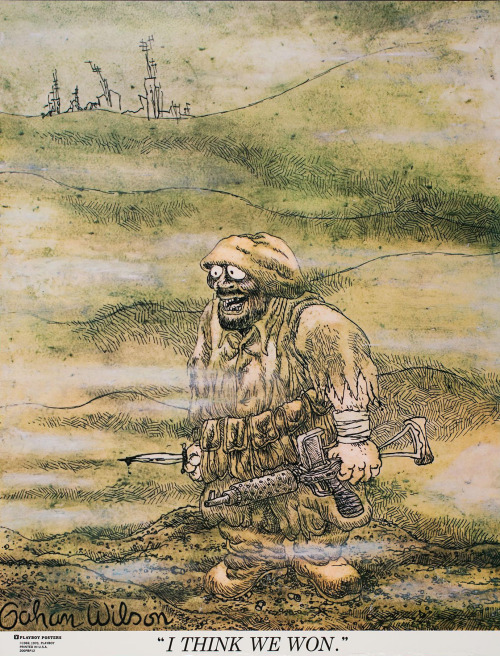#the way
Discerning Relevance
When the world shifts out of focus, the lights that shine most brightly may distract us as we seek to comprehend their relevance, but the colors define the bounds of our world and help us discern the way forward from the uncharted hazards lurking in the darkness. Our world becomes more clear and we press onward into the night.

Disruption
A flash of lightening on the horizon disrupts our view of a starlit night. A massive explosion of energy, illuminating an enigmatic and vaporous patch of heaven…violent, incongruous, unpredictable…so bright that, as we allow ourselves to be drawn into the scene, our perception of the night sky is washed out and we are left numb to the sight of the stars above and the serenity that continues to…

(viaMike Lynch Cartoons: Gahan Wilson’s “I think we won” Cartoon)
* * * *
“A good soldier is not violent.
A good fighter is not angry.
A good winner is not vengeful.
A good employer is humble.
This is known as the Virtue of not striving.
This is known as ability to deal with people.
This since ancient times has been known
as the ultimate unity with heaven.”
~ Lao-tzu
Post link
I am an avid fan of PBS travel shows. My family can attest to this. Ever since I was old enough to work the remote I gravitated towards television programs that showed the wonders of travel (I’m binging on them right now as I type this). Rick Steves is my spirit animal. Burt Wolf is my homeboy. I want to be BFFs with the cast of Globe Trekker.

You think I’m joking, but I totally did this pose after I renewed my passport. Ask my mom.
National Geographic magazines also sparks travel day dreams. My go to answers for the question, “What would be your dream job?” are “An astronaut, National Geographic photographer, and stationary store owner.” I’ve always longed to travel and see the world and get that coveted stamp in my passport.
So why don’t I want to be a tourist now?
My dreams of travel have not died. Have no fear of that. My perspective though has changed. I find that I relate more to the concept and practice of pilgrimage. Being a tourist is fun. Seeing new places is fun. Getting to relax is fun. But… to me, there is always something missing. Going on a pilgrimage is enriching and life giving. I wanted to take a minute to introduce you to my friend, the Pilgrimage.
Pilgrimage: It’s human nature.
At the heart of the pilgrimage is a journey. There’s preparation involved long before the first step is taken. Usually, there’s the understanding that the journey is an escape from the secular world and an entering into the sacred. The ordinary and familiar parts of life are left behind and replaced by something new, unfamiliar, and maybe unexpected. Typically there’s a connection to the past or a commemoration of something that had occurred in the area the pilgrim is headed. There may be a ritual involved as well. The re-entrance into every day life once the pilgrimage is over is also a critical component to the pilgrimage as a whole. A pilgrim comes back home changed.
I see pilgrimages as a natural part of being human. Since the dawn of man, humans have held certain areas of land as sacred. Caves, mountains, rivers, all drew early humans to make multiple return trips. To go to those areas was to encounter the sacred. As humans continued to encounter God, pilgrimages began to flocking to places held sacred to their faith. In the Buddhist tradition, where the Buddha walked, sat, and slept was kept sacred. Hindus have more than 1800 religious sites that pilgrims flock to on holy days to make give a sacrifice, make an offering, or complete a ritual such as bathing in the Ganges River at Banaras. In early Judaism, all faithful were expected to make a pilgrimage to the Temple in Jerusalem. While pilgrimages are no longer obligatory, many still go to the Western Wall to pray and travel to Jerusalem to celebrate Jewish holidays. In Islam, completing the Hajj or a Mecca at least once in their life is one of the five pillars of faith.

On pilgrimage to St. Peter’s Basilica at the Vatican. I’m pretty sure I was thinking, “I am such a small part of this big, beautiful church” and trying really hard to focus on the camera, even though my head naturally looked up.
Christians started making pilgrimages shortly after the death of Christ. The faithful would travel to where Jesus lived, preformed miracles, and died. For those who could not make a physical pilgrimage, they instead recited prayers and reflected upon the Stations of the Cross. Pilgrims also traveled to places related to those who knew Jesus, such as Mary’s home or where his apostles died. St. Peter’s Basilica in Rome is literally built over the area where Peter was buried and is one of the most popular pilgrim sites in the world. As more saints were added to the litany, more pilgrimage sites were established. The Camino de Santiago (or the Way of St. James), takes pilgrims from France, though mountains and farm fields to end at the shrine of the apostle St. James the Great in the Cathedral of Santiago de Compostela in Galicia, Spain. Walking on the path that can date back to the 9th century, pilgrims stay in hostelsand relying on the kindness of strangers.

St. Francis overlooking the valley below Assisi. This is supposed to be a representation of the “internal dimension” of a pilgrimage.
A Pilgrim’s Journey
Everyone experiences a pilgrimage is different. When I went to Assisi with some of my classmates, we all went to the same exact places. We came back home with very different experiences.
A pilgrim often grapples with an internal dimension that is very different from a tourist’s experience. Pilgrims take time to reflect up what occurred while they are on their way. Often they allow themselves to be open to receive and be ministered to by the experience and to let go of control. Each pilgrim goes on a pilgrimage for different reasons and what they focus on can transform the pilgrimage (for example, since most pilgrims go to Lourdes, France seeking healing in the miraculous waters of a spring given to a young girl by Mary their pilgrimage often has a theme of healing). A community of often built when strangers meet on the way. Even if you initially set out on your own, you will not travel alone. And last, the entire journey, from beginning to end, is important. While a tourist may just want to hurry up and get to the destination, pilgrims pay attention to the entire journey (the man who helped me through security on my first flight was part of my pilgrimage in the same way the customs officer I greeted when I landed back home was).
Watching Rick Steves share his knowledge on how to travel through Europe is very helpful, but I am looking forward to experiencing my own pilgrim journey. To see familiar sites and walk on hallowed ground. To be with old friends while meeting a million people. To be open to whatever happens and to listen to God’s call through the noise of a crowded piazza.

One of the best films depicting a person on a pilgrimage is “The Way,” staring Martin Sheen and written/directed by his son, Emilio Estevez. It was filmed on the actual Camino de Santiago.
Michael Hays
“The Way” (feat. Erik Haywood)
Red Willow
Every now and then I find these abstract videos I can’t really think of a description for. This isn’t one of them.
The common translation by Christians in China for the concept of Logos, a Greek word and concept referred to as “The Word” in English transcriptions, as it appears in John 1:1, is TaoorDao: “The Way”.







